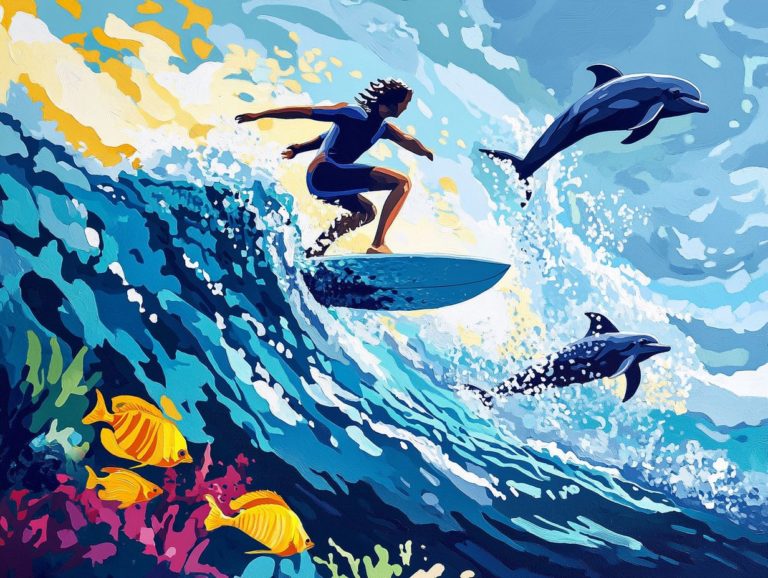Sustainable Fishing Practices for Travelers
Sustainable fishing transcends mere trendiness; it represents a vital strategy for safeguarding our oceans and marine ecosystems.
This article delves into the environmental repercussions of fishing. It underscores the urgent need for preservation and showcases various sustainable fishing methods available to you. You ll uncover tips that empower travelers to make responsible seafood choices. Furthermore, you’ll explore the distinct challenges and solutions present in different regions.
Moreover, you will discover how advocacy and education can champion sustainable practices. Together, we can contribute to a healthier planet.
Engage with us in the journey of understanding and supporting sustainable fishing for a brighter future.
Contents
- Key Takeaways:
- The Importance of Sustainable Fishing
- Types of Sustainable Fishing Methods
- How to Support Sustainable Fishing as a Traveler
- Sustainable Fishing in Different Regions
- Promoting Sustainable Fishing Practices and Environmental Awareness
- Frequently Asked Questions
- What are sustainable fishing practices for travelers?
- Why is it important for travelers to practice sustainable fishing?
- What are some examples of sustainable fishing practices for travelers?
- How can travelers ensure they support sustainable fishing practices?
- What are the benefits of sustainable fishing practices for travelers?
- What resources are available for travelers to learn more about sustainable fishing practices?
Key Takeaways:

- Act now! Support sustainable fishing by choosing seafood from responsibly managed fisheries.
- Learn about different fishing techniques and their environmental impact while traveling to coastal regions.
- Advocate for sustainable fishing practices by educating others and choosing responsible seafood options when dining out.
The Importance of Sustainable Fishing
Sustainable fishing is vital for preserving the health of our aquatic environments. It tackles the urgent concerns of catching too many fish too quickly and the degradation of marine ecosystems.
By embracing responsible angling practices like catch and release and opting for eco-friendly gear you can make a meaningful contribution to the conservation of fish populations and marine life.
Engaging with sustainability management and certification initiatives, like those from the Green Business Bureau, promotes ethical fishing practices. These practices support biodiversity preservation and help ensure the long-term availability of seafood.
Environmental Impact and Preservation
The environmental impact of fishing practices can profoundly affect marine ecosystems. It’s essential for you to embrace sustainability management strategies and implement fishing regulations to preserve biodiversity.
Overfishing and destructive techniques drive these practices. They lead to declining fish populations, disrupt the food chain, and endanger various species. The disturbance of seabeds and habitats compromises the health of the ecosystem, resulting in long-term consequences for marine biodiversity.
Effective sustainability management approaches require you to limit catch quotas. You should also keep track of the pollution produced by fishing activities. Understanding this highlights the urgent need for regulations that enforce responsible fishing methods. This ensures that aquatic life is protected for future generations while maintaining the delicate balance of oceanic ecosystems.
Types of Sustainable Fishing Methods
You ll find a variety of sustainable fishing methods utilized around the world. Each method is meticulously designed to reduce environmental impact while fostering the health of fish populations. This includes species like bluefin tuna, Chilean seabass, and beluga sturgeon, all of which face threats from unsustainable practices.
By embracing these methods, you contribute to the preservation of these vital marine resources.
Exploring Different Techniques

Exploring various fishing techniques opens up a world of sustainable practices. Techniques such as catch and release and the use of eco-friendly gear enable you and your fishing community to protect marine life while still satisfying seafood demand.
These approaches not only minimize bycatch and habitat destruction, but also help ensure that fish populations thrive for future generations. For instance, catch and release lets you enjoy the sport without risking depletion of stocks. Opting for biodegradable nets significantly reduces pollution.
However, challenges remain, including the need for widespread education on sustainable practices and ensuring compliance with fishing regulations. By embracing these techniques, you can align your fishing practices with conservation goals. Together, we can effectively balance ecological health with economic needs.
Your choices can make a difference! Together, we can protect our oceans for future generations.
How to Support Sustainable Fishing as a Traveler
As a traveler, you play a crucial role in supporting sustainable fishing. This practice is essential for maintaining the health of marine ecosystems and bolstering local fisheries.
You can make a real difference by consuming seafood responsibly and engaging with fishing initiatives that prioritize sustainability.
Tips for Responsible Seafood Consumption
Practicing responsible seafood consumption means making informed choices that support fishing communities dedicated to ethical practices.
To navigate this landscape effectively, explore resources designed to help you identify seafood options that are both delicious and environmentally friendly. One invaluable resource is Seafood Watch, which provides up-to-date information on sustainably sourced seafood. This guidance helps you make choices that align with your values.
Understanding fishing regulations is key. It ensures that the seafood you purchase complies with legal standards aimed at preserving fish populations and protecting marine ecosystems. By staying informed, you contribute to the health of our oceans and support fisheries that adhere to responsible practices. This effort fosters a more sustainable seafood market for generations to come.
Sustainable Fishing in Different Regions
Sustainable fishing practices vary greatly by region, each facing unique challenges and tailored solutions that resonate with the local ecosystems and specific fishing regulations imposed by the National Marine Fisheries Service.
The Gulf of Mexico and Eastern Pacific fisheries have unique guidelines that shape sustainability efforts in their waters.
Challenges and Solutions for Different Locations

The challenges facing sustainable fishing initiatives often arise from overfishing, insufficient regulations, and the pressing need for enhanced collaboration among conservation organizations and local fisheries.
In areas where fish populations have sharply declined due to excessive catch rates, local communities deal with both economic instability and significant environmental degradation. The issue of bycatch fish that are unintentionally captured adds another layer of complexity to this intricate situation.
To tackle these challenges, innovative solutions are emerging. Stricter quotas and the introduction of eco-friendly fishing gear are paving the way for more sustainable practices. Community engagement is crucial, as fishermen and conservationists work together to develop guidelines that promote responsible fishing and safeguard marine ecosystems. Additionally, adopting top sustainable travel practices can further support these efforts.
Promoting Sustainable Fishing Practices and Environmental Awareness
Promoting sustainable fishing practices requires a comprehensive strategy that blends advocacy, education, and active involvement from fishing communities and conservation organizations. This collaborative effort is essential to cultivate environmental awareness and encourage responsible fishing behaviors.
By engaging all stakeholders, you can foster a more sustainable future for our oceans and ensure that fishing remains a viable activity for generations to come.
Advocacy and Education
Advocacy and education are vital for promoting sustainable fishing. These efforts help protect fish populations and marine life.
Engaging the community through awareness campaigns can make a real difference. Targeted workshops and hands-on training sessions empower local fishermen to adopt best practices.
Programs that focus on eco-friendly gear and strict adherence to catch limits can change traditional fishing habits. As communities learn about marine ecosystems, they develop a greater sense of responsibility.
This shift fosters a commitment to mindful practices. Such actions enhance environmental stewardship and ensure fish stocks remain viable for future generations.
Frequently Asked Questions
What are sustainable fishing practices for travelers?

Sustainable fishing practices minimize environmental harm while supporting fish populations. They focus on responsible seafood consumption.
Why is it important for travelers to practice sustainable fishing?
Practicing sustainable fishing protects oceans for future generations. It also supports local economies reliant on fishing.
What are some examples of sustainable fishing practices for travelers?
Travelers can choose sustainably sourced seafood. Using eco-friendly gear and following local catch limits are also effective practices.
How can travelers ensure they support sustainable fishing practices?
Before traveling, research and choose restaurants and tour operators that prioritize sustainability. Ask questions and express support for responsible options.
What are the benefits of sustainable fishing practices for travelers?
Sustainable fishing benefits the environment and local communities. Travelers enjoy a more authentic experience by engaging in these practices.
What resources are available for travelers to learn more about sustainable fishing practices?
Many organizations promote sustainable fishing, such as Seafood Watch and Marine Stewardship Council. They provide valuable information and ways for travelers to positively impact marine ecosystems.






